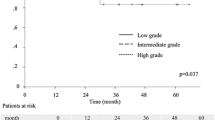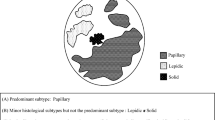Abstract
Background
The International association for the study of cancer (IASLC)/American thoracic society (ATS)/European respiratory society (ERS) has established a new subclassification of lung adenocarcinoma, especially for the lepidic pattern component, formerly called bronchioloalveolar adenocarcinoma (BAC). According to the new classification, BAC has been classified into the following 4 main subtypes: adenocarcinoma in situ (AIS), minimally invasive adenocarcinoma (MIA), invasive adenocarcinoma (IA), and variants of invasive adenocarcinoma (VIA). An observational study was conducted to validate this classification in patients with pathological stage IA pulmonary adenocarcinoma.
Patients and methods
147 patients treated for pathological stage IA lung adenocarcinoma by complete resection at Osaka University Medical Hospital from January 1993 to December 2002 were assessed. The tumor specimens of the cohort were classified into the 4 subgroups. In addition, these groups were compared for various prognostic factors.
Results
Adenocarcinoma in situ was observed in 30 patients, MIA in 8, IA in 104, and VIA in 5 patients, with 5-year survival rates of 100, 100, 85.5, and 60.0 %, respectively. The relationship between the histological classification and K-ras mutation was significant (p < 0.001), especially when comparing the VIA group with the others (p ≪ 0.001). Ki67-labeling indices were significantly different between the AIS and IA groups (p = 0.040).
Conclusions
This study validated the proposed IASLC/ATS/ERS classification for pulmonary adenocarcinoma in patients with pathological stage IA pulmonary adenocarcinoma. The difference between AIS and IA may depend on the proliferation of the carcinoma. In addition, the difference between VIA and the other adenocarcinoma types may depend on genetic factors, especially K-ras mutations.




Similar content being viewed by others
References
Parkin DM, Bray F, Ferlay J, Pisani P. Global cancer statistics, 2002. CA Cancer J Clin. 2005;55:74–108.
Goya T, Asamura H, Yoshimura H, Kato H, Shimokata K, Tsuchiya R, Sohara Y, Miya T, Miyaoka E. Japanese joint committee of lung cancer registry. Prognosis of 6644 resected non-small cell lung cancers in Japan: a Japanese lung cancer registry study. Lung Cancer. 2005;50:227–34.
Sawabata N, Miyaoka E, Asamura H, Nakanishi Y, Eguchi K, Mori M, Nomori H, Fujii Y, Okumura M, Yokoi K, For the Japanese joint committee for lung cancer registration. Japanese lung cancer registry study of 11,663 surgical cases in demographic and prognosis changes over decade. J Thorac Oncol. 2004;2011(6):1229–35.
Travis WD, Brambilla E, Noguchi M, et al. International association for the study of lung cancer/American thoracic society/European respiratory society international multidisciplinary classification of lung adenocarcinoma. J Thorac Oncol. 2011;6:244–85.
Noguchi M, Morikawa A, Kawasaki M, et al. Small adenocarcinoma of the lung histologic characteristics and prognosis. Cancer. 1995;75:2844–52.
Watanabe S, Watanabe T, Arai K, et al. Results of wedge resection for focal bronchioloalveolar carcinoma showing pure ground-glass attenuation on computed tomography. Ann Thorac Surg. 2002;73:1071–5.
Sakurai H, Dobashi Y, Mizutani E, et al. Bronchioloalveolar carcinoma of the lung 3 centimeters or less in diameter: a prognostic assessment. Ann Thorac Surg. 2004;78:1728–33.
Yarden Y. The EGFR family and its ligands in human cancer. Signalling mechanisms and therapeutic opportunities. Eur J Cancer. 2001;37(Suppl 4):S3–8.
Paez JG, Jänne PA, Lee JC, et al. EGFR mutations in lung cancer: correlation with clinical response to gefitinib therapy. Science. 2004;304:1497–500.
Lynch TJ, Bell DW, Sordella R, et al. Activating mutations in the epidermal growth factor receptor underlying responsiveness of non-small-cell lung cancer to gefitinib. N Engl J Med. 2004;350:2129–39.
Shigematsu H, Lin L, Takahashi T, et al. Clinical and biological features associated with epidermal growth factor receptor gene mutations in lung cancers. J Natl Cancer Inst. 2005;97:339–46.
Yoshizawa A, Sumiyoshi S, Sonobe M, et al. Validation of the IASLC/ATS/ERS lung adenocarcinoma classification for prognosis and association with EGFR and KRAS gene mutations: analysis of 440 Japanese patients. J Thorac Oncol. 2013;8:52–61.
Shigematsu H, Gazdar AF. Somatic mutations of epidermal growth factor receptor signaling pathway in lung cancers. Int J Cancer. 2006;118:257–62.
Mitsudomi T, Viallet J, Mulshine JL, et al. Mutations of ras genes distinguish a subset of non-small-cell lung cancer cell lines from small-cell lung cancer cell lines. Oncogene. 1991;6:1353–62.
Soda M, Choi YL, Enomoto M, et al. Identification of the transforming EML4-ALK fusion gene in non-small-cell lung cancer. Nature. 2007;448:561–6.
Wong DW, Leung EL, So KK, et al. The EML4-ALK fusion gene is involved in various histologic types of lung cancers from nonsmokers with wild-type EGFR and KRAS. Cancer. 2009;115:1723–33.
Inamura K, Takeuchi K, Togashi Y, et al. EML4-ALK lung cancer are characterized by rare other mutations, a TTF-a cell lineage, an cinar histology, and young onset. Mod Pathol. 2009;22:508–15.
Shaw AT, Yeap BY, Mino-Kenudson M, et al. Clinical features and outcome of patients with non-small-cell lung cancer who harbor EML4-ALK. J Clin Oncol. 2009;27:4247–53.
Shintani Y, Okimura A, Sato K, et al. Epithelial to mesenchymal transition is a determinant of sensitivity to chemoradiotherapy in non-small cell lung cancer. Ann Thorac Surg. 2011;92:1794–804.
Shintani Y, Maeda M, Chaika N, Johnson KR, Wheelock MJ. Collagen I promotes epithelial-to-mesenchymal transition in lung cancer cells via transforming growth factor-beta signaling. Am J Respir Cell Mol Biol. 2008;38:95–104.
Shintani Y, Hollingsworth MA, Wheelock MJ, Johnson KR. Collagen I promotes metastasis in pancreatic cancer by activating c-Jun NH(2)-terminal kinase 1 and up-regulating N-cadherin expression. Cancer Res. 2006;66:11745–53.
Nozawa N, Hashimoto S, Nakashima Y, et al. Immunohistochemical α- and β-catenin and E-cadherin expression and their clinicopathological significance in human lung adenocarcinoma. Pathol Res Pract. 2006;202:639–50.
Conflict of interest
All the authors have declared no competing interest.
Author information
Authors and Affiliations
Corresponding author
Rights and permissions
About this article
Cite this article
Nakagiri, T., Sawabata, N., Morii, E. et al. Evaluation of the new IASLC/ATS/ERS proposed classification of adenocarcinoma based on lepidic pattern in patients with pathological stage IA pulmonary adenocarcinoma. Gen Thorac Cardiovasc Surg 62, 671–677 (2014). https://doi.org/10.1007/s11748-014-0429-3
Received:
Accepted:
Published:
Issue Date:
DOI: https://doi.org/10.1007/s11748-014-0429-3




